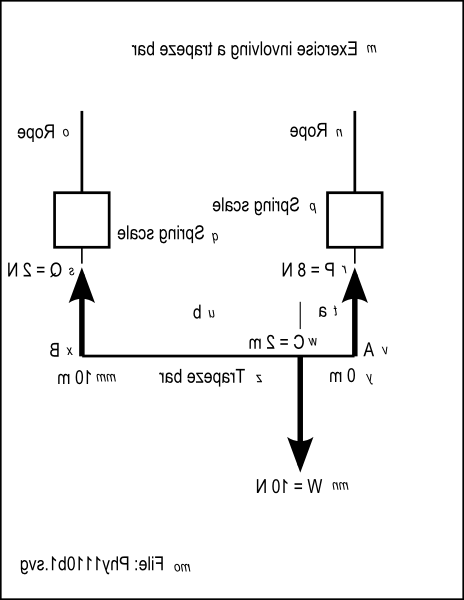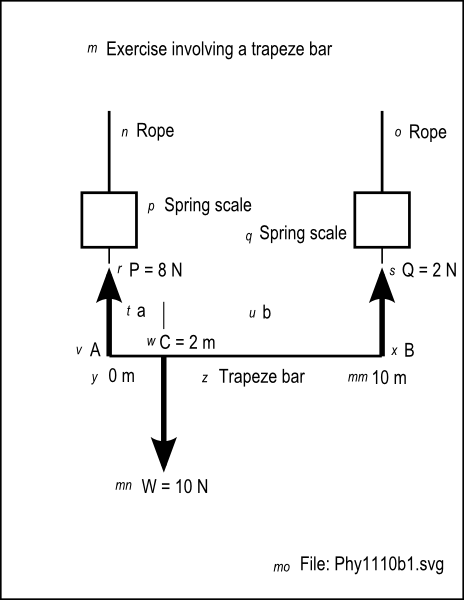| << Chapter < Page | Chapter >> Page > |
We will compute the relationship between pounds-force and kilograms-force using the force unit of newtons an intermediary.
We will assume that the acceleration of gravity is either 32.17 ft/s^2 or 9.81 m/s^2.
The calculations are shown in Figure 4 .
| Figure 4 . Relationship between pound-force and kilogram-force. |
|---|
Begin with known conversion factors:
1 lbf = 1 pound * 32.17 * ft/s^21 pound = 0.45 * kg
Substitute kg for pound.1 lbf = 0.45 * kg * 32.17 * ft/s^2
Substitute meters for feet.1 ft = 0.30 m
1 lbf = 0.45 * kg * 32.17 * 0.30 * m/s^2Do the arithmetic and substitute (1 N)
for (1 kg*m/s^2)1 lbf = 4.34 * kg*m/s^2 = 4.34 N
Now compute the relationship between kgf and NBegin with some more known quantities.
1 kgf = 1 kg * 9.81 * m/s^21 N = 1 kg*m/s^2
Substitute (1 N) for (1 kg * m/s^2)1 kgf = 9.81 N
Now form a ratio between 1 lbf and 1 kgf1 lbf/1 kgf = (4.34 N)/(9.81 N)
Cancel like terms, do the arithmetic, andmultiply both sides by kgf.
1 lbf = 0.44 kgf |
Is this the correct answer?
According to the online units converter ,
1 pound-force (lbf) = 0.45359237 kilogram-force (kgf)
Considering that I rounded all computations to two decimal digits, my result is pretty close.
Apply conversion factor to the spring scale calibration
We now have a conversion factor that allows us to convert between lbf and kgf:
1 pound-force (lbf) = 0.45359237 kilogram-force (kgf)
If we multiply 20 lbf by0.45 to convert that value to force in units of kgf, we get 9.0 kgf. This agrees with the calibrations on my spring scale.
What do these terms really mean?
One lbf is the amount of force that is required to cause a one-pound mass to accelerate at 32.2 ft/s^2 due to the force of gravity.
One kgf is the amount of force required to cause a one-kg mass to accelerate at 9.81 m/s^2 due to the force of gravity.
Use your graph board to construct a picture that looks something like a very longtrapeze bar. By this, I mean a horizontal bar with a rope tied to each end. The other end of each rope is firmly attached to the ceiling. Make the horizontalbar ten meters in length.
Tactile graphics
The file named Phy1110b1.svg contains an image that represents this scenario. The image shows the trapeze bar, the ropes, and the spring scales. The imagealso shows vectors that represent the forces acting on the trapeze bar.
Figure 5 shows the mirror image that is contained in that file for the benefit of your assistant who will create the tactilegraphic for this exercise.
| Figure 5 . Mirror image from the file named Phy1110b1.svg. |
|---|
 |
Figure 6 shows a non-mirror-image version of the same image.
| Figure 6 . Non-mirror-image version of the image from the file named Phy1110b1.svg. |
|---|
 |
Figure 7 shows the key-value pairs that go with the image in the file named Phy1110b1.svg.
| Figure 7 . Key-value pairs for the image in the file named Phy1110b1.svg. |
|---|
m: Exercise involving a trapeze bar
n: Ropeo: Rope
p: Spring scaleq: Spring scale
r: P = 8 Ns: Q = 2 N
t: au: b
v: Aw: C = 2 m
x: By: 0 m
z: Trapeze barmm: 10 m
mn: W = 10 Nmo: File: Phy1110b1.svg |

Notification Switch
Would you like to follow the 'Accessible physics concepts for blind students' conversation and receive update notifications?